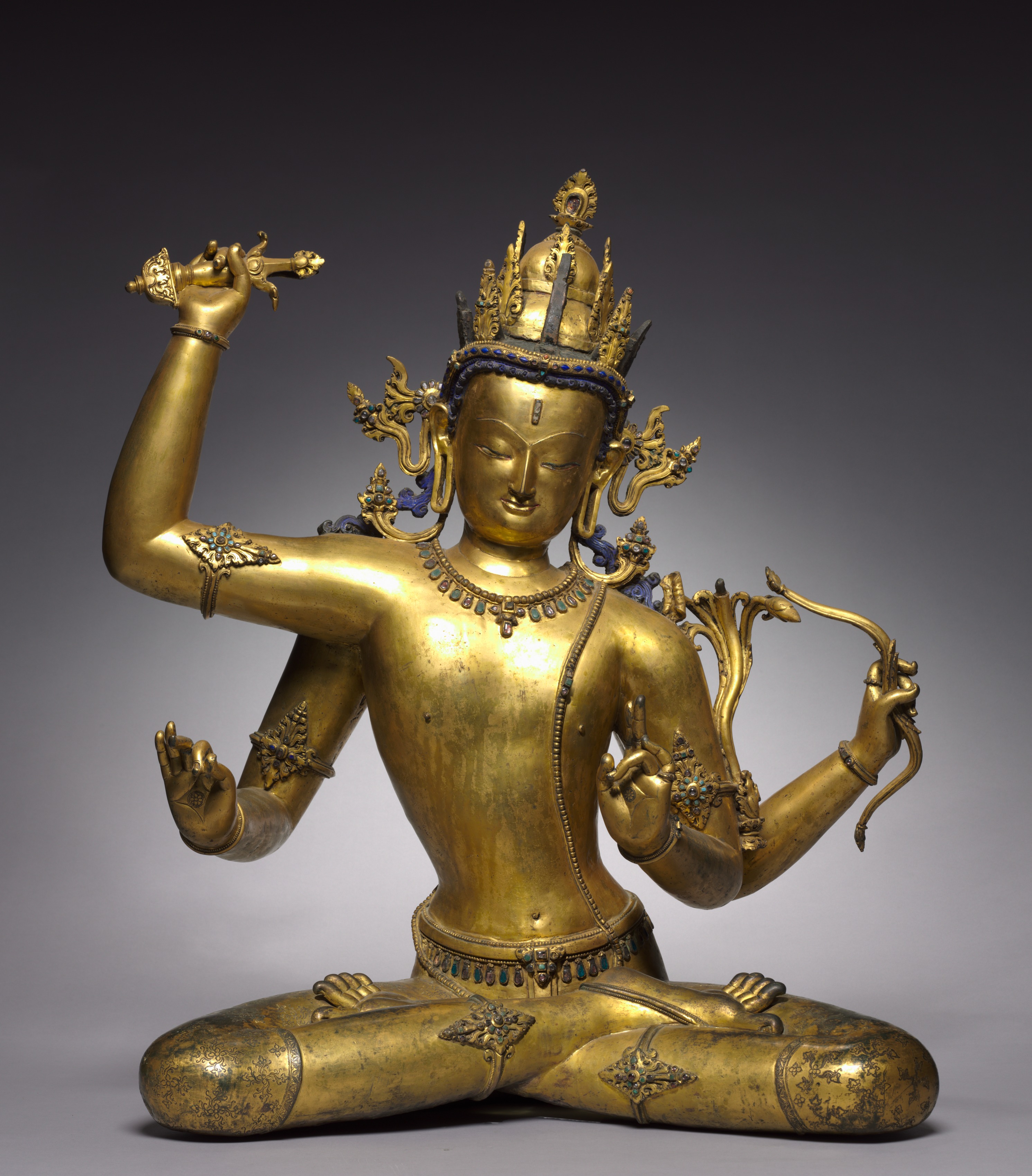The Cleveland Museum of Art
Collection Online as of April 19, 2024

Bodhisattva of Wisdom (Manjushri)
1400s
Overall: 78.1 x 67.6 cm (30 3/4 x 26 5/8 in.)
Leonard C. Hanna, Jr. Fund 1964.370
Location: 237 Himalayan
Did You Know?
The bodhisattva's short breeches are patterned in spiraling floral forms incised into the metal.Description
This image depicts one of the main bodhisattvas, beings only one stage away from full enlightenment. Because the historical Buddha was a prince prior to his renunciation and life as a wandering ascetic, bodhisattvas are depicted as royal princes. This example has the sharp features, sweet expression, and crisp details characteristic of images made in Nepal during the 1400s.In his upraised right hand Manjushri holds the hilt of a sword that, like wisdom itself, metaphorically cuts through and defeats ignorance. His lower, rear left hand grasps a bow, once probably strung with a wire. Also missing is the arrow that he likely held in his lowered right hand. Arrows were often symbols for mantras, or strings of syllables thought to have the power to focus the mind and work like missiles to destroy negativity and affliction. The gesture of his lowered left hand indicates the transmission of Buddhist teachings. The lotus stem that rises at the left elbows originally held a book of sutras.
This figure is in the yogic posture of meditation with the big toe flexed in concentration. Yoga is of central importance in tantric Buddhism, because high-level practitioners are able to discipline the body to such an extent that the mind can also be controlled.
- ?–1964(J.J. Klejman [1906–1995], New York, NY, sold to the Cleveland Museum of Art)1964–The Cleveland Museum of Art, Cleveland, OH
- The Cleveland Museum of Art. Handbook of the Cleveland Museum of Art/1966. Cleveland, OH: The Cleveland Museum of Art, 1966. Reproduced: p. 234 archive.orgCleveland Museum of Art, “Golden Anniversary Acquisition,” 1966, Cleveland Museum of Art Archives. archive.orgThe Cleveland Museum of Art. Handbook of the Cleveland Museum of Art/1969. Cleveland, OH: The Cleveland Museum of Art, 1969.. Reproduced: p. 234 archive.orgThe Cleveland Museum of Art. Handbook of the Cleveland Museum of Art/1978. Cleveland, OH: The Cleveland Museum of Art, 1978. Reproduced: p. 297 archive.orgSlusser, Mary Shepherd. “Serpents, Sages, and Sorcerers in Cleveland.” The Bulletin of the Cleveland Museum of Art 66, no. 2 (February 1979): 67–82. Mentioned and Reproduced: fig. 10, p. 71 www.jstor.orgSchroeder, Ulrich von. Indo-Tibetan Bronzes. Hong Kong: Visual Dharma Publications, 1981. Mentioned and Reproduced: no. 94D, pp. 356–357Reedy, Chandra L. Himalayan Bronzes: Technology, Style, and Choices. Newark: University of Delaware Press, 1997. Reproduced: p. 241, fig. N281Béguin, Gilles. Buddhist Art: An Historical and Cultural Journey. Bangkok: River Books, 2009. Reproduced: p. 253, fig. 7Bidwell, Frederick E. and Leslie Cade. The CMA Companion: A Guide to the Cleveland Museum of Art. Cleveland, OH: The Cleveland Museum of Art; New York, NY: Scala Arts Publishers, 2014. Mentioned and Reproduced: p. 219
- Asian Journeys: Collecting Art in Post-war America. The Asia Society Museum, New York, NY (organizer) (February 10-August 9, 2009).Golden Anniversary of Acquisitions. The Cleveland Museum of Art, Cleveland, OH (organizer) (September 10-October 16, 1966).
- {{cite web|title=Bodhisattva of Wisdom (Manjushri)|url=false|author=|year=1400s|access-date=19 April 2024|publisher=Cleveland Museum of Art}}
Source URL:
https://www.clevelandart.org/art/1964.370